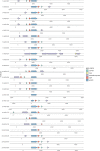Characterization of qnrB-carrying plasmids from ESBL- and non-ESBL-producing Escherichia coli
- PMID: 35549890
- PMCID: PMC9101827
- DOI: 10.1186/s12864-022-08564-y
Characterization of qnrB-carrying plasmids from ESBL- and non-ESBL-producing Escherichia coli
Abstract
Background: Escherichia coli carrying clinically important antimicrobial resistances [i.e., against extended-spectrum-beta-lactamases (ESBL)] are of high concern for human health and are increasingly detected worldwide. Worryingly, they are often identified as multidrug-resistant (MDR) isolates, frequently including resistances against quinolones/fluoroquinolones.
Results: Here, the occurrence and genetic basis of the fluoroquinolone resistance enhancing determinant qnrB in ESBL-/non-ESBL-producing E. coli was investigated. Overall, 33 qnrB-carrying isolates out of the annual German antimicrobial resistance (AMR) monitoring on commensal E. coli (incl. ESBL-/AmpC-producing E. coli) recovered from food and livestock between 2013 and 2018 were analysed in detail. Whole-genome sequencing, bioinformatics analyses and transferability evaluation was conducted to characterise the prevailing qnrB-associated plasmids. Furthermore, predominant qnrB-carrying plasmid-types were subjected to in silico genome reconstruction analysis. In general, the qnrB-carrying E. coli were found to be highly heterogenic in their multilocus sequence types (STs) and their phenotypic resistance profiles. Most of them appeared to be MDR and exhibited resistances against up to ten antimicrobials of different classes. With respect to qnrB-carrying plasmids, we found qnrB19 located on small Col440I plasmids to be most widespread among ESBL-producing E. coli from German livestock and food. This Col440I plasmid-type was found to be highly conserved by exhibiting qnrB19, a pspF operon and different genes of unassigned function. Furthermore, we detected plasmids of the incompatibility groups IncN and IncH as carriers of qnrB. All qnrB-carrying plasmids also exhibited virulence factors and various insertion sequences (IS). The majority of the qnrB-carrying plasmids were determined to be self-transmissible, indicating their possible contribution to the spread of resistances against (fluoro)quinolones and other antimicrobials.
Conclusion: In this study, a diversity of different plasmid types carrying qnrB alone or in combination with other resistance determinants (i.e., beta-lactamase genes) were found. The spread of these plasmids, especially those carrying antimicrobial resistance genes against highest priority critically important antimicrobial agents, is highly unfavourable and can pose a threat for public health. Therefore, the dissemination pathways and evolution of these plasmids need to be further monitored.
Keywords: E. coli; Fluoroquinolone; Inc-group; Plasmids; qnrB.
© 2022. The Author(s).
Conflict of interest statement
The authors declare that they have no competing interests.
Figures




Similar articles
-
Occurrence of the Colistin Resistance Gene mcr-1 and Additional Antibiotic Resistance Genes in ESBL/AmpC-Producing Escherichia coli from Poultry in Lebanon: A Nationwide Survey.Microbiol Spectr. 2021 Oct 31;9(2):e0002521. doi: 10.1128/Spectrum.00025-21. Epub 2021 Sep 8. Microbiol Spectr. 2021. PMID: 34494875 Free PMC article.
-
Whole genome sequence analysis of antimicrobial resistance genes, multilocus sequence types and plasmid sequences in ESBL/AmpC Escherichia coli isolated from broiler caecum and meat.Int J Food Microbiol. 2020 Feb 16;315:108361. doi: 10.1016/j.ijfoodmicro.2019.108361. Epub 2019 Oct 29. Int J Food Microbiol. 2020. PMID: 31734617
-
Dissemination and characterisation of Escherichia coli producing extended-spectrum β-lactamases, AmpC β-lactamases and metallo-β-lactamases from livestock and poultry in Northeast India: A molecular surveillance approach.J Glob Antimicrob Resist. 2019 Jun;17:209-215. doi: 10.1016/j.jgar.2018.12.025. Epub 2019 Jan 8. J Glob Antimicrob Resist. 2019. PMID: 30634056
-
Antimicrobial Resistance in Escherichia coli.Microbiol Spectr. 2018 Jul;6(4):10.1128/microbiolspec.arba-0026-2017. doi: 10.1128/microbiolspec.ARBA-0026-2017. Microbiol Spectr. 2018. PMID: 30003866 Free PMC article. Review.
-
A review of the mechanisms that confer antibiotic resistance in pathotypes of E. coli.Front Cell Infect Microbiol. 2024 Apr 4;14:1387497. doi: 10.3389/fcimb.2024.1387497. eCollection 2024. Front Cell Infect Microbiol. 2024. PMID: 38638826 Free PMC article. Review.
Cited by
-
High Prevalence of Plasmid-Mediated Quinolone Resistance among ESBL/AmpC-Producing Enterobacterales from Free-Living Birds in Poland.Int J Mol Sci. 2023 Aug 15;24(16):12804. doi: 10.3390/ijms241612804. Int J Mol Sci. 2023. PMID: 37628984 Free PMC article.
-
Characteristics of antimicrobial resistance in Escherichia coli isolated from retail meat products in North Carolina.PLoS One. 2024 Jan 5;19(1):e0294099. doi: 10.1371/journal.pone.0294099. eCollection 2024. PLoS One. 2024. PMID: 38180979 Free PMC article.
-
Molecular epidemiology of extended-spectrum beta-lactamase-producing-Klebsiella species in East Tennessee dairy cattle farms.Front Microbiol. 2024 Sep 24;15:1439363. doi: 10.3389/fmicb.2024.1439363. eCollection 2024. Front Microbiol. 2024. PMID: 39380685 Free PMC article.
-
Antimicrobial resistance and molecular detection of extended-spectrum ß-lactamase (ESBL)-producing Escherichia coli in municipal wastewater in Marrakech.PLoS One. 2025 Jun 16;20(6):e0325816. doi: 10.1371/journal.pone.0325816. eCollection 2025. PLoS One. 2025. PMID: 40522962 Free PMC article.
-
Molecular epidemiology and pathogenomics of extended-spectrum beta-lactamase producing- Escherichia coli and - Klebsiella pneumoniae isolates from bulk tank milk in Tennessee, USA.Front Microbiol. 2023 Nov 6;14:1283165. doi: 10.3389/fmicb.2023.1283165. eCollection 2023. Front Microbiol. 2023. PMID: 38029210 Free PMC article.
References
-
- WHO, Critically Important Antimicrobials for Human Medicine. WHO Library Cataloguing-in-Publication Data, 2018. 6.
MeSH terms
Substances
LinkOut - more resources
Full Text Sources
Medical

